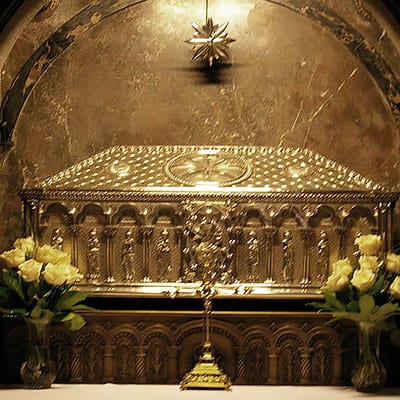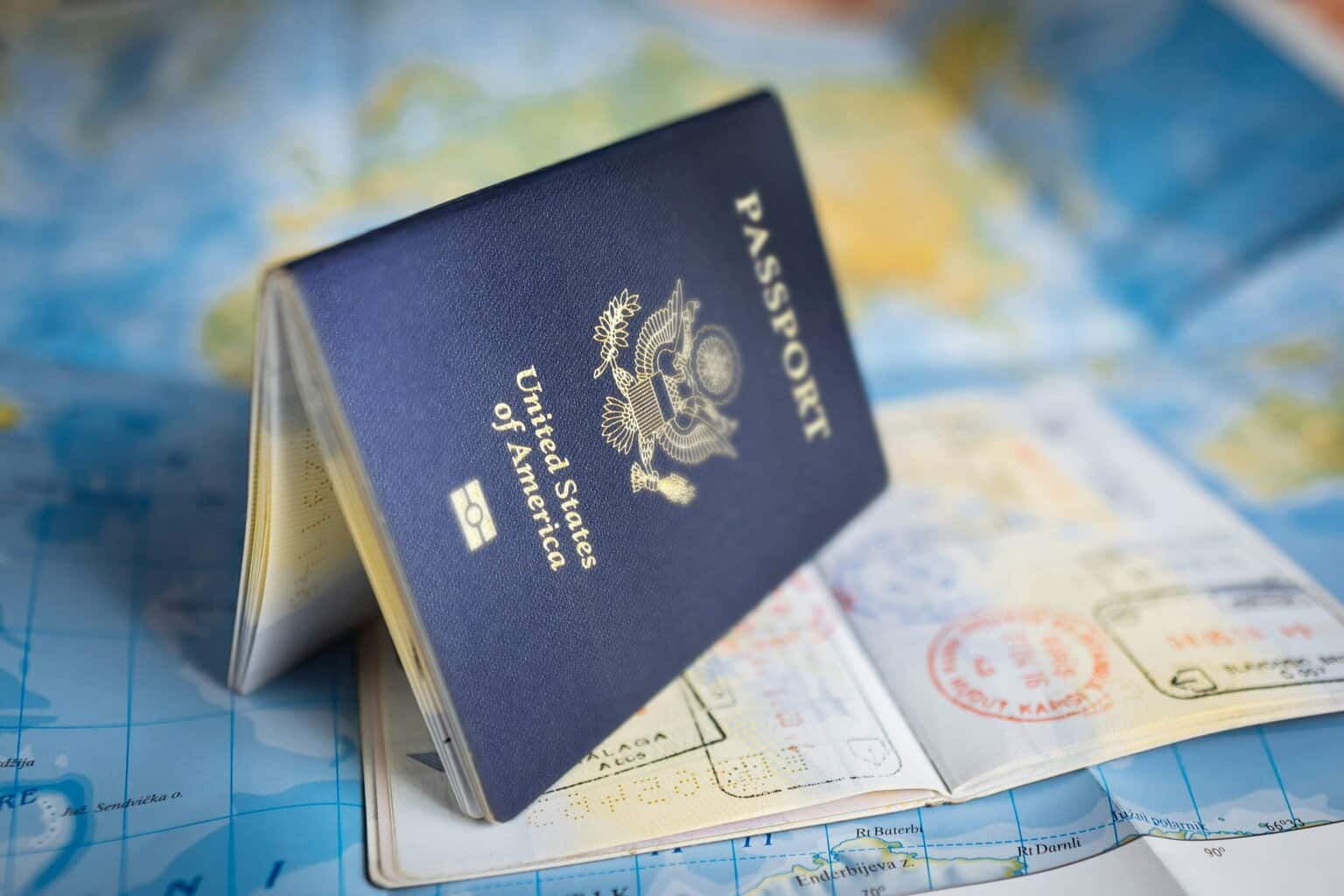What comes to mind when you think about Camino de Santiago symbols? Do you think of the scallop shell? The yellow arrow? And what about the other symbols of the Camino de Santiago? From pilgrim hats to walking sticks, these symbols help to understand the history, culture, and traditions of this ancient pilgrimage to Santiago de Compostela. Let us explore some of the best-known items.
Some Camino de Santiago symbols have a true historical origin, while others are just metaphorical. After reading this post, you will have a few interesting facts to share with your fellow pilgrims on your way.
Please note: We do not provide scallop shells in our holiday pack in support of our sustainability initiatives.
The scallop shell, one of the main symbols of the Camino de Santiago
Above all other El Camino de Santiago symbols, the scallop shell (or “Viera”) is the most well-known and iconic. It is closely related to the history of the Jacobean route. Most importantly, it appears reflected on the Codex Calixtinus. Clergymen would give it to pilgrims on their arrival at Santiago de Compostela city as accreditation for completing their pilgrimage.
From ancient times to today, the scallop shell has accompanied pilgrims on their way to Santiago. On the other hand, now that people can buy scallop shells online, they are no longer proof of walking the Camino. However, the significance and tradition of carrying the shell with you on the Camino are still alive.
Did you know? The scallop shell’s scientific name is Pecten Jacobaeus, further proof of the significance of this as one of the main symbols of the Camino de Santiago.
Origin of the scallop shell as a symbol
There is a wide variety of stories, legends, and myths about the origin of the Camino de Santiago shell. The most popular that you will hear are:

#1 The association of the scallop shell with pilgrimage is related to its use by pilgrims to drink water from springs and streams.
#2 Its popularisation as one of the Camino de Santiago symbols came after the settlement of some merchants around the cathedral of Santiago in the Middle Ages. They sold the Vieiras that they took from the Galician sea as a souvenir to the pilgrims.
#3 The Concha of Santiago can be traced back to when the disciple visited the Spanish peninsula by boat. This was in order to bury the remains of St James. Unfortunately, a storm destroyed the ship After some time, St James’s body was found undamaged and covered in scallop shells along the seashore.
#4 On their arrival at the Galician coast, the disciples saw a wedding that was taking place on the shore. The bride was on horseback, suddenly the frightened horse dove into the ocean with the bride still on the saddle. Thankfully, both the bride and the horse emerged from the water safe and sound covered in scallop shells.
#5 There is another version that associates the scallop shell with Venus, the goddess of love. As Venus’s symbol signifies people’s rebirth, the resurrection. This means overcoming the ego to move forward to a true self, more humble and simple. It also means the beginnings and endings, transition and transformation. All ideas shared by pilgrims and discovered on the Camino today, a constant source of renewal and rediscovery.
Did you know? Venus rose from the sea on a scallop shell. Botticelli’s painting “The Birth of Venus”, depicts this scene. In addition, the scallop shell is associated with fertility rituals practised along the route.
The scallop shell as a healing tool
The scallop shell is associated with one of the 23 miracles performed by St James. When St James cured a knight who suffered from a throat disease by putting a scallop on the affected area, word spread and people started to put scallops near their beds, hanging them on the outside door, putting it near animals drinking places.
Some medieval texts give the shell the virtue of chasing rodents from fields or purifying water and wine.
Did you know? The scallop shell is not only associated with the St James Way. In the 12th century, they were reportedly sold in Mont St Michel in France. Emperor Charles IV received scallops as a present from the French king when he was passing by Paris on his pilgrimage.
What is the significance of the scallop shell on the Camino?

Nowadays, the scallop shell sign is printed on hundreds of milestones in yellow colour on a blue background along the different Camino routes. It indicates the path to pilgrims on their way to Santiago de Compostela.
You can pick up countless souvenirs and mementoes emblazoned with the shell. Which make a great talking point to those who’ve been or want to go. You’ll also notice that churches along the Camino and churches named St James around the world will proudly display this ancient icon as a testament to their connection with the saint.
Did you know? In French, the scallop is called Coquille Saint Jacques and in German Jakobsmuscheln (James mussels).
Other symbols of the Camino
It is true that the scallop shell is one of the most representative symbols of the Camino de Santiago. However, it is not the only one. There are other objects, signs, or places strongly related to the Camino:
The Cross of St James
This particular Latin cross simulates a sword and its arms take the shape of a Fleur-De-Lys. Its red colour represents Jesus’s blood and the white background is a sign of purity.
Its origin is related to the times of the Crusades, the Crusaders carried small sharp-edge crosses with them to be able to push them into the ground and pray in the presence of the Cross.
It is common to see pilgrims today carrying St James cross as a pin on their backpack or hat, and some scallop shells will have the symbol painted onto them.
Did you know? St James was beheaded with a sword so the cross of St James is also a symbol of his suffering.
The Pilgrim’s Passport

The credential or Pilgrim’s Passport is the way that pilgrims prove that they have accomplished their pilgrimage.
It’s like a passport in which pilgrims have to collect stamps on the different stages of their journey.
If you would like to receive your Compostela then you will need to show the stamps that you have received along the journey, covering at least 100km if you have walked, or 200km if you have cycled.
We will send you your own credential with your Holiday Pack when you book with Follow the Camino.
The Compostela
It is the certificate that pilgrims can get at the end of their Camino to Santiago de Compostela. They receive the Compostela by walking 100km on foot. Additionally, people cycling the Camino need to accomplish a minimum of 200 km to request it.
The Pilgrim’s Office is the organization in charge of issuing this certificate and where people can request their Compostela certificate.
Gourd – “Calabaza”

In the past, pilgrims used a gourd (similar to a butternut pumpkin) as a tool to carry water. It was often carried by attaching it to their wooden walking stick.
It was a light, practical and cheap way to keep you hydrated along the way. Its use today is less practical, people just use it in a symbolic way to remember the history of the trail and the people who walked before them.
The Camino Hat
The typical Camino hat is a wide-brimmed hat that can be folded as a half-moon. As you can imagine, pilgrims walking for long hours under the Spanish sun can get easily sunburned if not using proper protection. The wide brim kept the sun off, so this is the main reason why it became a tradition for pilgrims to wear it.
Nowadays, you will see a much wider variety of hats along the way. You can read more about what to pack for the Camino here.
The Milestone

Milestones are blocks of concrete or stone that indicate the way to follow and the remaining distance to reach Santiago de Compostela.
They have the characteristic yellow scallop shell, usually on a blue background, printed on them and they are usually separated by 1 kilometre.
The main exception to this is in Galicia where they are separated by only 500 meters. On some of the less walked Caminos, you won’t find as many stones along the way.
A Wooden Stick or “Bordón”
For generations, pilgrims have walked with a wooden stick that helped to relieve the impact on their knees when walking. Nowadays, the traditional wooden stick (“bordón” or “cayado”) has been replaced by all types of advanced lightweight metal walking poles. If you are walking with weaker ankles or knees, a good pair of walking poles can make a massive difference.
Yellow Arrow

Apart from the Scallop Shell, there is no other symbol that better symbolizes the Way of St James than the yellow arrow. The arrow guides pilgrims in the right direction. Furthermore, it is printed on milestones, wooden sticks, walls, rocks, paths, and more along the Camino.
Its origin is very curious, it dates back to the 70s when Elias Valiña, a priest from the O Cebreiro church, started to mark with a yellow arrow the route from the Pyrenees to Santiago de Compostela. He’s also the author of the first Camino guide published in the 80s.
Still more curious is the significance of the yellow colour which was used for no other reason than it was free. It was the colour of paint used by the workers to paint the roads around the area.
If you’re walking along the Portuguese Coastal Way you’ll also find green arrows to guide you to Santiago.
Important! If you see blue arrows on the Portuguese Way, do not follow them, unless you want to reach Fatima in Portugal (the opposite direction to Santiago).
The Codex Calixtinus
The manuscript Codex Calixtinus is the most renowned and relevant document of the Jacobean pilgrimage. It compiles five books of all the liturgical texts (Masses, homilies, sermons), Jacobean traditions, the 22 most famous miracles of Santiago, and the history of the pilgrimage made in France and Spain to reach Santiago between the X and XII centuries.
The Botafumeiro

Weighing more than 60 kg and 1.60 m in height, the Santiago de Compostela Botafumeiro is one of the largest incense burners in the world.
This is one of the most significant symbols of the Santiago cathedral; it’s made of silver-plated brass and is filled with incense and charcoal that is made to “fly”, swinging from one side to another tied to a large rope to perfume the temple.
Pilgrims who finish their pilgrimage on special dates like St James, Assumption, Easter Sunday, etc., can see the Botafumeiro censer in action as a part of the mass. Apart from these special occasions, the flying of the Botafumeiro is done on random days or at the request (and expense!) of guests.
The Jacobean Year, Holy Year
A far-reaching time of the year for Christians and Camino enthusiasts is St James Day (25th July). When July 25th occurs on a Sunday, it is referred to as a Holy Year or Jacobean Year.
Believers who visit the tomb of St James in Santiago will be granted the plenary indulgence, the absolution of all their sins.
To obtain forgiveness of their sins, devotees have to go to confession within 15 days before visiting the St James Cathedral. After they pass through the Holy Door (Porta Sancta), which is only open to the public in Holy years, they have to pray in the cathedral and attend Mass.
Did you know? There is a Jacobean year every 6, 5, 6, and 11 years. The next Xacobeo years will be in 2021, 2022, 2027, and 2032.
Tomb of St James

At the end of your walk to Santiago de Compostela, you’ll see the cathedral of Santiago de Compostela. It is a tradition to visit the tomb of St James which is located inside the cathedral in an underground crypt.
There, worshippers kneel to pray in front of the cedar box, a beautiful example of 19th-century silverwork, where the remains of the apostle and his two disciples are.
The Holy Door (Porta Santa), St James Cathedral
The emblematic Holy Door or “Porta Santa”, is located on the backside of the St James Cathedral, where the Plaza de Quintana is and it only opens on the eve of the Holy Year, Jubilee years.
The tradition is the believers, pilgrims and curious enter who enter through this door may piously gain the plenary indulgences attached with the Jubilee year celebrations.
Cruceiros

One of the Camino de Santiago symbols that you’ll see the most along The Way is the Cruceiros. This stone cross or crucifix was said to forgive some sins. And they were said to protect travellers on their journeys.
On the front side, you’ll see the crucified Christ and on the opposite side, you’ll mainly see an image of the Virgin Mary.
They are religious artefacts integrated into the landscape. They are embedded in the local culture of the region that crosses the Camino de Santiago.
Have you seen any other symbols of the Camino de Santiago? Let us know!
Let Follow the Camino bring you on the Way
Here at Follow the Camino, we are constantly talking to other Camino experts about what is happening on the Camino. We know what is changing, what is coming up, and what the best things to do are. Our team have loads more top tips for your Camino, from choosing the best route to what to pack and how to prepare.
If you are dreaming of walking one of the famous Camino routes one day, get in touch with us! We would love to help you choose the best route for you and help you to plan your Camino adventure.







